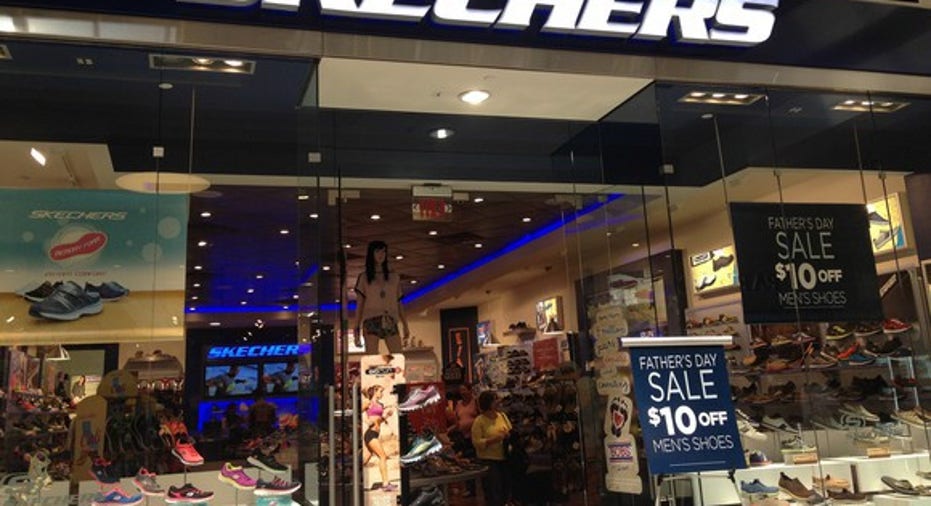Should Investors Be Worried About Skechers' Slowing Growth?

Image source: The Motley Fool.
After last year's spectacular 32.4% revenue increase, growth for Skechers (NYSE: SKX) has cooled off in recent quarters. Revenue in the first quarter increased by 27.4%, but substantially slowed to a 9.7% increase in the second quarter. Despite the revenue increase last quarter, net income declined 7.1% to $74.1 million. The stock plunged more than 20% the day after the earnings report and is now down roughly 30% since that second-quarter earnings report came out on July 21.
A challenging retail environment combined with the closure of several major sporting-goods stores put downward pressure on Skechers' sales. Let's take a closer look at some of the factors leading to the company's slower growth, and how it's planning to overcome these challenges.
Overcoming retail headwinds
Skechers' slowing growth rates were primarily a result of weakness in its domestic business, which accounted for 58.1% of its revenue in the second quarter. Compared to the second quarter of 2015, domestic wholesale net sales decreased 5.4% in this year's second quarter, while sales at domestic stores that have been open at least a year didn't increase or decrease. According to management, the decrease in domestic wholesale was largely a result of orders being pulled forward into the first quarter as Easter moved from April in 2015 to March in 2016, and domestic wholesale should increase by low to mid-single digits the rest of the year.
With more people purchasing online, the bricks-and-mortar retail environment continues to be extremely competitive, and many companies have been relying on promotional strategies like discounting and coupons to boost sales and traffic.
In addition, many companies, including Skechers, were impacted by the closing of hundreds of Sports Authority and Sport Chalet stores nationwide over the last two quarters. Not only did Skechers lose two of its wholesale customers, but the closure of these chains also led to excess inventory being liquidated at significant discounts. Skechers CFO David Weinberg said during the July conference call that the excess of "sale-priced product from big brands that are very rarely on sale" encouraged some customers to purchase shoes from other brands.
The hit that Skechers saw as other brands were offered at a discount should be abating, as Sports Authority finishedliquidating and closing its remaining stores in August, but it will take a while for all the sale-priced merchandise to work its way out of the system.
While the closing of several chains added to a challenging retail environment, I don't expect it to continue having an adverse impact on Skechers' sales. The company has been working with its wholesale customers to increase the amount of shelf space dedicated to its products and Skechers should also benefit as another one of its key wholesale customers, Dick's Sporting Goods (NYSE: DKS), continues expanding its store base. Dick's Sporting Goods hasn't faced the same retail woes as some of its competitors, and plans to open 36 additional locations this year.
On top of competitive pressures, Skechers' profits in the second quarter were negatively impacted by foreign-currency translation and exchange losses of $8.3 million, an additional $2.7 million in value-added taxes in Brazil, and a fire in its Malaysian warehouse that resulted in a pre-tax loss of $900,000. These three things combined brought earnings per share down $0.07, to $0.50, in the second quarter. While the warehouse fire in Malaysia was an unusual expense, the company expects foreign exchange rates to continue to weigh on international profits and it could face higher taxes as it continues to do more business overseas.
Skechers is banking on international growth
Despite broader challenges in the domestic retail environment, Skechers' international business continues to grow at a rapid pace and second-quarter international revenue accounted for 41.9% of the company's sales. In the second quarter, international subsidiary and joint-venture revenue increased 34.6%, and international company-owned retail increased by 40.5%. The company's growth has been particularly strong across Asia: Net sales for its joint ventures in Asia grew by 65.5%, fueled by high double-digit growth in China and triple-digit growth in India.
Skechers is counting on strong growth in Asia, and continues to invest in expanding its store base there. In the second quarter it opened 42 stores in China, bringing its store count there to 233, and it now has approximately 1,550 points of sale across the country.
Time to worry, or time to buy?
While the slowdown in revenue growth last quarter was greater than analysts expected, I don't think it warranted the 30% drop in the stock price over the past several months. After the large price drop, it could be worth taking a closer look. The company appears to be relatively cheap with a price-to-earnings ratio close to 13.0 in the past several months.
The company is still projecting growth in its domestic and international business the rest of the year, as it continues to expand its store base and wholesale accounts. I don't expect the company to repeat 2015's impressive 32.4% increase in revenue, but it should be able to continue delivering double-digit revenue growth for the next several years.
A secret billion-dollar stock opportunity The world's biggest tech company forgot to show you something, but a few Wall Street analysts and the Fool didn't miss a beat: There's a small company that's powering their brand-new gadgets and the coming revolution in technology. And we think its stock price has nearly unlimited room to run for early in-the-know investors! To be one of them, just click here.
Ben Estep has no position in any stocks mentioned. The Motley Fool owns shares of and recommends Skechers. Try any of our Foolish newsletter services free for 30 days. We Fools may not all hold the same opinions, but we all believe that considering a diverse range of insights makes us better investors. The Motley Fool has a disclosure policy.